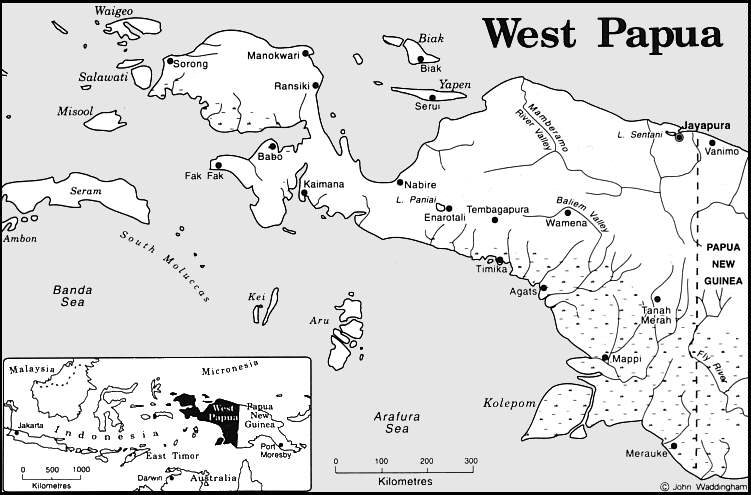
Black & White Irian Jaya/West Papua New Guinea photos are here: B&W West Papua New Guinea
A few more Irian Jaya/West Papua New Guinea photos are here: 1, 2, 3, 4, 5, 6, 7
Biak/Yapen/Aibai Islands Photo Gallery
Gupy, my Lani porter, although not understanding a word of my song, laughed as the two of us walked alone on the mountain trail in West Papua, New Guinea. His amusement was because I was singing a mean a cappella Cocaine Blues. Not just mean, it was subterranean mean, you know, below average. :-) He had been singing for quite awhile and so when he got tired and stopped singing I decided to return the favor. Although I cannot prove it, I am very confident that no other person in the history of the world had walked that trail singing Cocaine Blues and, I dare say, no one has since. I have made my mark, albeit a rather obscure one! That is just one of the wonderful, amusing memories I have of this fantastic adventure! By the way, it was the wonderful, best version of Cocaine Blues by George Thorogood and the Destroyers from 1978 that I had in mind. :-)
On October 4, 1995 I started the long journey and flew from San Francisco to Los Angeles to Honolulu to Jakarta, Indonesia. There I had a 12 hour layover until I could catch my flight to Sentani on the north coast of Irian Jaya. The flight to Sentani took all night and included stops in Denpasar, Bali and Biak. The total time to get to Sentani from home was 49 long hours.

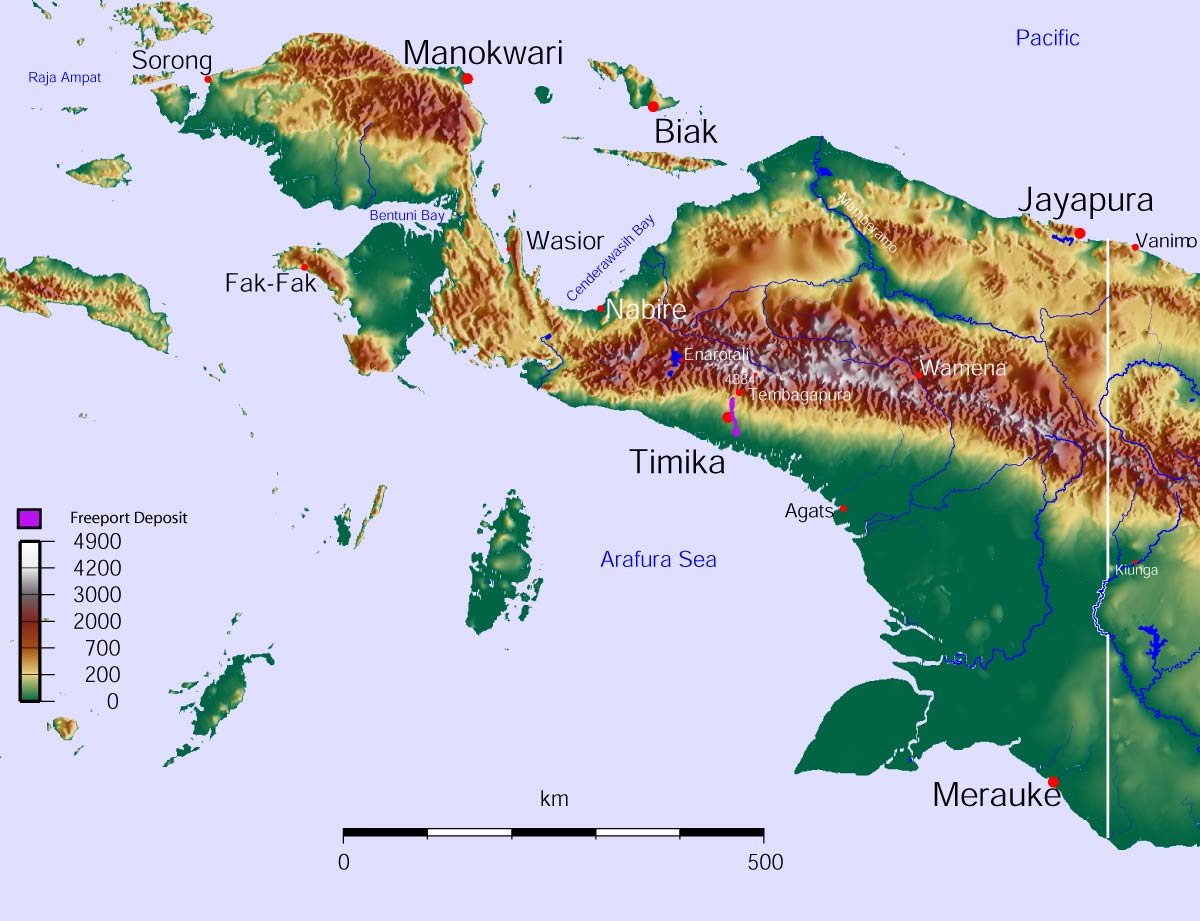
Irian Jaya or West Papua is the west half of the island of New Guinea and just 3 degrees south of the equator. New Guinea is the second largest island in the world and it is one of the most remote and primitive places left on Earth. The people of the interior have only moved out of the Stone Age in the last 30-40 years (as of my 1995 trip). Up until the 1950s stone tools were the norm. It wasn't until steel was introduced to them by outsiders that steel axe heads, knife blades, etc. became common. Before that stone axe heads and bone knives were all they had. In the south, headhunting and cannibalism were also common up until a generation or two ago. Some parts of Irian Jaya are still not truly explored and maps often have blank spots where there is not enough information available to fill in the details. The island of New Guinea is home to about 800, or 1/4, of the world's known languages. The rugged terrain meant that people in one area had little contact with people in another area even if the distance was not great.
The chance to be able to visit people and cultures that have changed little in hundreds or even thousands of years was very compelling for me because it is the people that interest me the most. My trips to Africa were wonderful, but this trip allowed me to see and experience an old way of living, that has been less affected by influence from the outside world, much more intimately. I will never forget it.
Arriving at the little airport at Sentani on Saturday, October 7th in the morning I was very tired and that, along with the combination of heat and humidity, made me want to just find a cool place to shower and sleep. Fortunately the small hotel that I was to meet my fellow trekkers at on Sunday was only a short walk from the little airport. As soon as I got a room I showered and slept until evening. The next day the other people that I would be travelling with started to arrive. There was a couple from England (Richard and Rosemary), a couple from New York (Jeff and Stephanie), a woman also from New York (Chelsea), a man from Australia (Garry), a man from Belgium (Gerard -- Jery), and a woman from Australia (Angela who had spent the last four years living in Indonesia, and spoke Indonesian). That night we all ate dinner together and tried to get to know each other. It seemed like I had a good group of fellow travellers.
As usual I had brought an SLR (Minolta Alpha 707si) for my travels. Since this was a backpacking trip I had to really minimize the gear and film so I had no backup SLR, but I did bring an Olympus Stylus compact camera too. I only had space to bring a couple of lenses on this trip. Also, I brought rolls of Fujichrome 100 slide film that were removed from their boxes and from the plastic cans to save space and weight -- I just kept them all in a big ziplock plastic bag.
Monday was spent mostly in preparation for the trek. We purchased a lot of food to take with us and got our backpacks, etc. packed up. Anything that was not needed on the trek could be left behind in Sentani, so I donated my old Marine Corps sea bag (duffle bag) with padlock for that purpose. I had travelled lighter than most, so I didn't need to leave anything behind, but most of the others had brought things that they no longer felt were essential for the trek. We packed it all up, locked the bag, and left it with the owner of the family-run hotel. That afternoon a few of us went on a hot day hike to a nice waterfall and were able to soak in the cool water at its base.
Tuesday morning we drove to Jayapura to get more supplies for the trek. The marketplace in Jayapura was interesting, but generally what we saw of the town was not so I was happy to return to the little town of Sentani. That evening some of us took a boat ride on Danau Sentani (Lake Sentani) to one of the islands with a fishing village and explored for awhile. The lake is large (148,000 sq km) with 19 islands. It is a very beautiful lake with many egrets and we all thoroughly enjoyed the afternoon there.
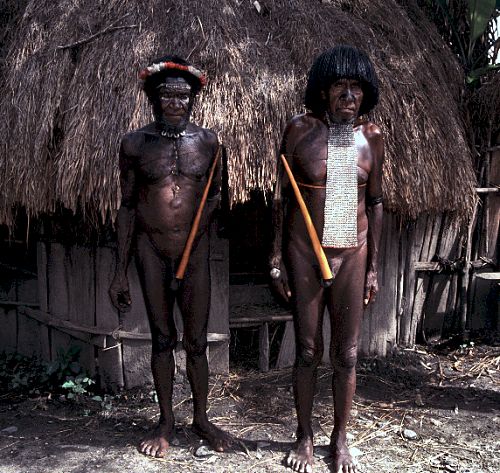 Dani men
Dani men
Wednesday morning we got up early and flew to Wamena in the Baliem Valley in the interior of Irian Jaya. Our trip was really beginning now! From Sentani to Wamena took about an hour flying over the rugged mountains and jungle until we passed over a peak and suddenly the wonderfully beautiful and expansive Baliem Valley was laid out below and ahead. It was such a contrast to what we had been watching out the windows for the previous hour. From the plane we could see small villages composed of wood and grass huts dotting the valley floor.
 Rufus
Rufus
In Wamena we hired a local guide, Rufus, and he hired porters for our trek. We each had a personal porter for our backpacks and about 8 additional porters for food and equipment. In addition, we hired a cook. The porters and cook were all Lani men and most spoke little or no English. Most could speak some Indonesian though and, of course, Lani. I think all of them could speak at least one other tribal language also. Rufus could speak Indonesian well and his English was not bad. The Lani are the tribe of people in the western Baliem Highlands. In total we numbered about 30.
That night the 9 of us and Rufus sat around with a map and discussed where we should trek. I made it clear that my first priority was going where the fewest others had gone previously, even if that meant a difficult trek. Fortunately, it seemed we all basically agreed about that, so Rufus suggested a route to the west of the Baliem Valley that would make a big loop. He said that very few people had gone there before and it was his first time to lead a group through there -- although he knew the area from personal experience already. As it turned out, most of the porters were from villages in that area -- the Lani people -- and, so, along the way, occasionally, we would pass through the home village of one of the porters or meet their friends and family on the trail. I surmise that for that reason the porters enjoyed the trek more than usual. I got the impression that they felt important going through their home territory as part of this strange group of foreigners. :-)
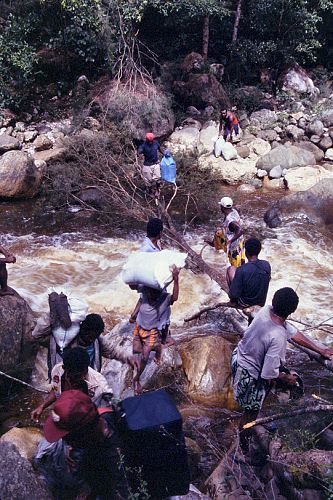 Mountain river
Mountain river
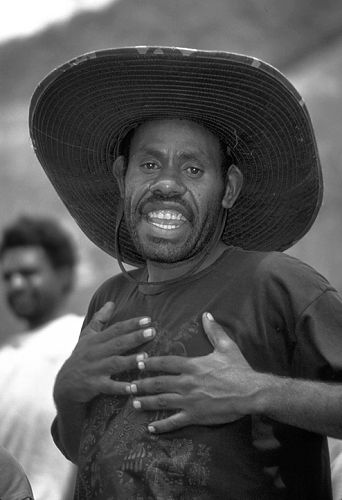 Gupy
Gupy
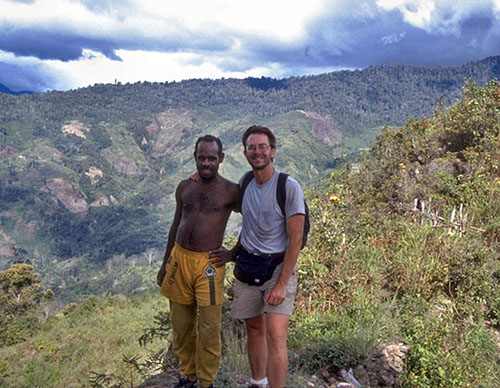 Me and Gupy
Me and Gupy
In Wamena on the morning on the day we started the trek I saw that Rufus bought a pack of cigarettes and gave it to all the porters. There were more of them than there were cigarettes, but they shared, smoked, and laughed while waiting for us to go. I mentioned to the others in our group that we should each buy some packs of cigarettes to give to the porters during the two weeks of the trek since the porters clearly enjoyed them so much. None of us were smokers. The others felt they didn't want to buy any for the porters though so I went alone to the nearby small Indonesian run shop and bought a couple of packs of Indonesian cigarettes for my porter. I put them in my small zipper waistpack that also contained rolls of film, extra camera battery, small flashlight, some toilet paper, etc. If we had all bought two or three packs each then there would have been enough for all the porters for the two weeks, I think.
The trek started off innocuously enough. The porters, packs, food, and equipment all piled into the back of a big dumptruck and we got into a van for the 2 hour ride from Wamena to the western edge of the Baliem Valley. Upon arriving at the end of the dirt road we all climbed out and porters started picking up gear and packs. It turned out that one of the real characters and cut-ups of the group, Gupy (pronounced "Goopy"), grabbed my pack, so he was my personal porter for the whole trek. Since we got a late start that morning we only hiked for about 4 hours that first day. There were some very steep uphills, but the trail was dry and relatively easy to walk on -- a huge contrast to most of the rest of the trek. :-) We got into a village late in the afternoon and Rufus negotiated with the headman for us to stay there for the night.
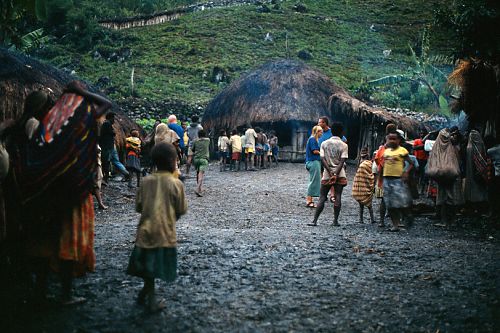 First night village
First night village
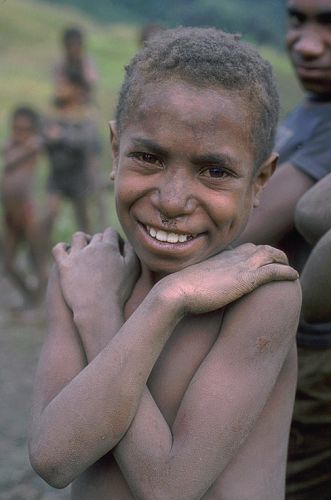 Lani boy
Lani boy
What followed were 12 days of:
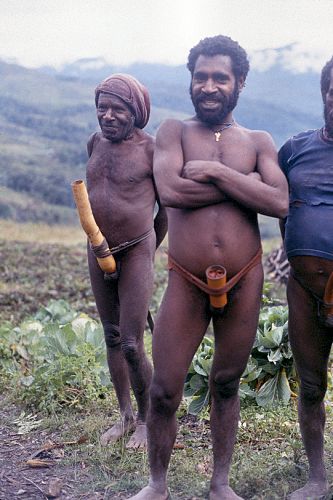
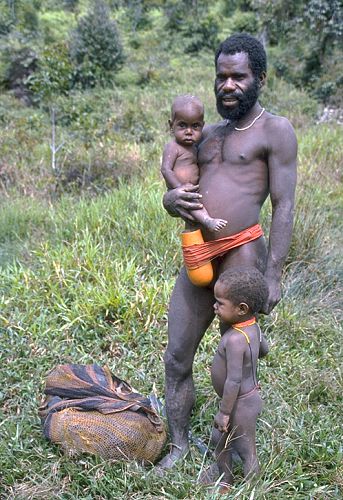
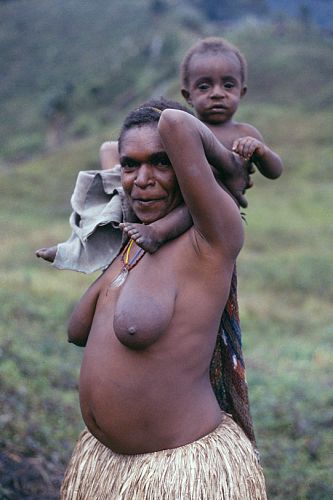
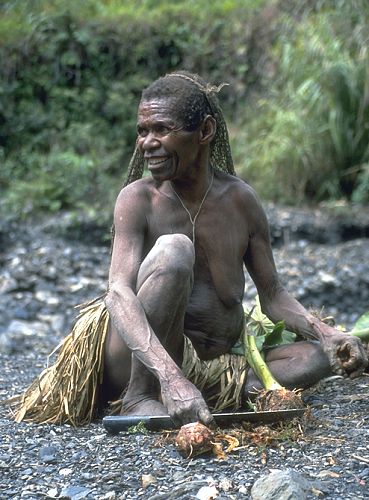
The Lani men we met usually wore only a penis gourd (horim). The Lani women typically were bare above the waist and wore either a grass skirt or a skirt made of twisted bark strings. The Lani children generally were completely nude although the boys very often had a thin string tied around their waist. The closer to "civilization" (I use that term loosely) we were the more often we saw people wearing old, dirty, raggedy western clothes, but the further out we got the less and less of that we saw.
Many women, especially the older ones, were missing parts of their fingers. It was the custom that when a male relative of a woman died that she would have one of her fingers chopped off at the second joint as a sign of mourning. It was believed that she would recover from her grief much faster. Many old women that I met had several, or even all, of their fingers cut off. I was told the thumb was never cut off though. Rufus told me that the uncle of the man that died would determine if and who would get their finger cut off. He said it is not done often these days, but in some villages they still do it. Occasionally we would see a man or woman with part of the ear cut off too. Rufus said that it was sometimes done for the same reason.
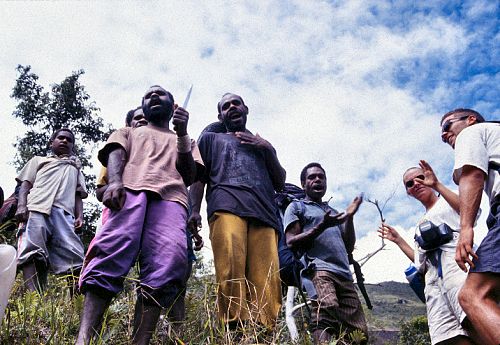 Porters singing
Porters singing
As we hiked, our porters would often sing along the trail. I had the impression that it was not only a way of passing the time for them, but, also, to inform villages up ahead that we were coming. The first few days of the trek all of us tended to walk fairly close on the trail to each other, but as the days wore on we (the porters and us) tended to spread out great distances. The person at the front and the person at the rear might be separated by more than an hour. We were quite a procession!
Along the trail when we stopped for a break I would usually take out a pack of cigarettes, take one out, and give it to Gupy. The first time I did this on the first day he was so happy and surprised. He happily smoked it, but I wished I had enough to give to all the porters. About the second or third time I gave him one he indicated he would like two so that he could give one to his best friend Amius. So I did so. By the third day though Gupy and Amius clearly felt uncomfortable smoking in front of all the other porters who had none, just as I felt uncomfortable about it too. Gupy in his simple, broken English asked if I would give cigarettes to everyone. Of course, I very much wanted to do this, but it would be the end of the cache I had left. I took out all the cigarettes I had left and showed them to him. I then asked what he wanted to do. And, naturally, he wanted to give them out. I happily gave him all that was left and he passed them around to the whole gang. I was gratified that they were all happy, but that was the end of the cigarettes for the rest of the trek. My trekking companions who had not wanted to give cigarettes to the porters lamented that they had not bought any after they saw how hard they worked, how well they took care of us, and how happy they were to smoke during a break. I had tried to convince them to buy some earlier when they had had the chance though.
By the fourth day of the trek Jery had decided that he could not take anymore. As the days got more and more difficult the chance of falling off a slippery, muddy 4 inch wide trail and sliding far below to the rocky river or falling off a wet, slippery 6 inch diameter log 10 feet above a rushing mountain stream strewn with rocks and boulders loomed larger and larger in his mind. He especially liked to talk to me and during almost every break he would confide his sincere worry that one of us would get seriously injured or even be killed. We were getting further and further from civilization, so if an accident was to occur the injured person would have to be carried for days to the nearest primitive medical facilities. From there it would take many hours or even days to get to the nearest modern medical facilities. At the end of the trek the rest of us discussed it and discovered that we had all secretly harbored similar apprehensions, albeit not as strong as Jery's. We had all determined that we wouldn't pass up a chance like this though!
While in a relatively large village on the morning of the fourth day Jery told us that he wanted to return. We left him with one of our porters and they planned to walk back to the Baliem Valley and then get transport back to Wamena. From there Jery could get a plane back to Sentani. He told us that he would wait in Sentani for us to arrive about 9 days later. We didn't expect him to still be there when we arrived though. As the days went on we all felt sure that Jery had made the right decision for himself. Things got much more difficult after he left.
The Lani people's ability to quickly and almost cavalierly walk on such narrow, slippery, muddy trails and logs is amazing. In their bare feet they make their way seemingly effortlessly while carrying packs and bundles. In our case, besides the physical exertion of often going up or down very steep paths we had to maintain 100% mental concentration on the task at hand for hours. If our confidence flagged when it was necessary to cross a slippery log one of the porters was always there to precede us walking backwards and holding our hands. Whenever we had to wade across a roaring, rushing, rocky river or stream the porters were there to lend a steadying hand. The porters were absolutely wonderful. By the end of the trip we all felt such a strong affection for them.
Gupy carried my backpack each day, but I had the lightest of anyone in our group. My backpack only weighed about 10-11 kg. Most of the others were 15 kg or so. I packed light. However, my daypack that I carried was fairly heavy because all the heavy stuff was in it: SLR camera body, 2 lenses, flash, film, flashlight, knife, 2 liter bottle of water + 1 liter bottle of water, toilet paper, extra batteries for cameras, flash, and flashlight, snack, towel, extra socks, sunscreen, etc.. In addition, I had a waist pack with my compact camera, more film, passport, airplane tickets, etc..
Every morning the cook would boil water for our water bottles over a campfire. It was almost always a very dingy brown and usually didn't taste too great, but most of us stayed fairly healthy. People had a few bouts of diarrhea and constipation, but other than that we were lucky.
Each morning we would get up around 6:00 and by 7:00 AM we were usually eating breakfast. Most of our meals were a similar combination of rice, fried noodles, boiled vegetables, Irian Jayan sweet potatoes (usually fried), and in the beginning we occasionally had some canned sardines or canned corned beef. The canned stuff was heavy though so we didn't bring much and it ran out soon. Each meal did not necessarily include all of the previously mentioned items though. Everything except the vegetables and potatoes were brought along and carried by the porters. The vegetables and potatoes were acquired along the way from the villagers we met. We also had the chance to occasionally get pineapples (delicious!) and oval cucumbers (wonderful to eat like an apple on a hot day -- but it is important to peel it first). By the end of the trek I was sure getting tired of rice and noodles three times a day! I was starting to have daydreams of a pizza...
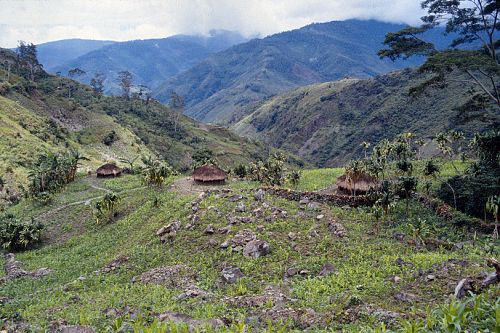 Village
Village
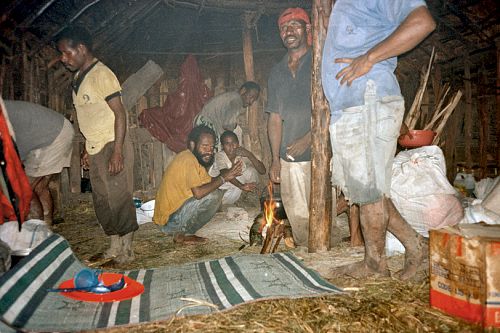 Porters in men's hut
Porters in men's hut
Most days Rufus would have us stop around 4:00 or 5:00 PM (after about 8 hours of hiking) at a village and he would negotiate to let us stay in one hut and all the porters in another. Most villages consisted of just 3-5 huts. A Lani village consists of a men's hut, a women's hut or huts, and a cooking hut. The men's hut is usually the largest. The men and women sleep separately and the children sleep with the women. The pigs typically sleep in the huts with the people. The pigs are often treated more like pets than livestock.
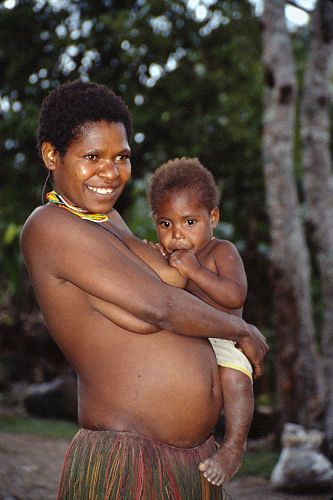 Lani woman with child
Lani woman with child
A Lani man can buy a wife for the typical price of 4 pigs. A Lani man can have as many wives as he can afford. However, most can only afford one or two. Pigs are a very important part of the Lani culture and are not killed often. They are a form of currency and are generally only killed for festivals. After a Lani woman has a baby she does not have sex again for 4 years. I'm not sure of the reason for this custom, but it seems to work very well to ensure that a mother never has more than one small child at a time to take care of. It helps reduce the child mortality rate because all of her attention is devoted to that one child.
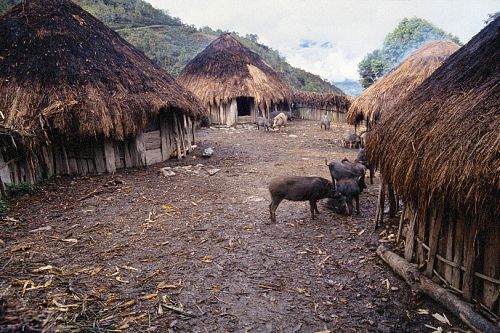 Smoke emanating from thatched roof
Smoke emanating from thatched roof
The Lani huts are about 12 feet in diameter, made of wood, with a grass thatched roof. The floor is often, but not always, raised about a foot off the ground and covered with straw. Occasionally the floor is just the straw covered ground. The ceiling is usually only about 4 feet high because there is often a second "floor" that is used for storage. One must stoop to crawl in through the "door" since it is only about 3 feet high and wide. Of course, there are no windows, so the inside is very dark even during the daytime. In the center there is a place for a fire which is built every night or when it is cool. There is no chimney or other opening for the smoke to escape from so it just fills the hut and eventually seeps through the thatch. From the outside it appears like there is a smoldering fire in the thatch because smoke is emanating from the whole roof's surface. As you can imagine, being inside a hut while there is a fire burning is not a pleasant experience. I went into a couple during the course of the trip, but had to leave quickly. In the hut we slept in we never built a fire, although the porters would often try to "help" us by gathering wood and attempting to get one going in our hut. It must have seemed strange to the porters and villagers that we would sleep in the hut without a fire. Naturally, throughout the night we could hear coughing coming from where people were sleeping in smoke-filled huts.
Even though the villagers would move out of a hut and clear the pigs out so that we could sleep in it they invariably neglected to remove the multitude of fleas. Each night that we stayed in a hut we were bitten by more fleas to add to our already countless flea bites. They would get inside the sleeping bags so that even when we had the chance to stay in a village that had a wooden floored schoolhouse we were still bitten by more fleas! Rosemary, in particular, was bothered by the fleas. After a few nights of sleeping with the fleas she had many infected flea bites all over her arms and shoulders. She just couldn't stop scratching them so they turned into infected sores. The rest of us all had flea bites but, fortunately, we did not scratch them so much so they weren't infected. Poor Rosemary!
Something we all had though were blisters on our feet. I was very careful to keep mine clean and put antiseptic on them every night, but two of them still got infected. Our feet and socks were generally wet and it was difficult to get anything to dry. Hot, wet boots are a good breeding ground for infections. All of us had infected sores by the end of the trek, but they rapidly started to heal after it was over and we were able to keep ourselves reasonably clean and dry.
The other aspect of sleeping in the huts at night was the rats. At night in the pitch black hut we could hear them scurrying around. In one hut there were a particularly large number of rats and all night they were moving around and gnawing on things. That night we all zipped ourselves up in our sleeping bags, but soon I was so hot I couldn't stand it anymore so I got out of mine and just lay on top of it using a sheet as a cover. At least 3 times during the night a rat crawled over me: twice over my legs and once over my back. All night I could hear a rat crawling around on my backpack which was sitting about a foot from my head. Every once in awhile I would reach out and hit the pack and the rat would scurry away. Soon he would return. I kept hearing him gnawing at something, but since I had no food there I couldn't figure out what it might be. Then suddenly I had the horrible thought that it might be my sweat-soaked pack straps that he was gnawing at. There was salt in them. I quickly felt around for my flashlight because I was worried that he might be chewing through the straps. It would be very difficult to carry the pack for the rest of the trek if the straps had been eaten through. I found the flashlight, turned it on, and the rat disappeared in a flash. I checked my straps, but they were okay. I never discovered what that rat kept gnawing on all night.
Needless to say, none of us slept a lot that night. Although, the next morning the person next to me told me that I had definitely slept some because I had been snoring! Rosemary reported that a rat crawled over her hair during the night too. Chelsea said she had bordered on hysteria and had hidden her head down inside of her sleeping bag all night. She was adamant that she could not handle another night like that. Fortunately, none of us had to though, because it was the second to last night of the trek and the last night we slept in a larger village that had a schoolhouse.
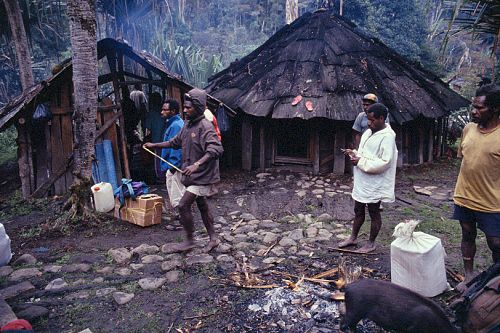 Day 5 village
Day 5 village
The afternoon of day 5 we descended down a mountain through a thick jungle to a raging river. Part of the river we had to wade through with the very necessary help of the porters and then the last, most difficult section, we had to climb onto a fallen tree that connected a large outcropping of rocks to the far shore. Each of us, with the help of two porters, managed to get over the fallen tree and then a short walk up led to a small 2 hut village in the deep jungle. It was almost dark already and all of us were wet. By then my knees, ankles and feet were becoming sore and the infected blisters on my feet were making walking very painful. We discovered that only one old man lived in this village. Strange. He seemed very surprised, but happy for us to arrive. Possibly this "village" was merely a place for hunters or travellers to stay at.
It must have been a good excuse for a celebration so he brought out 2 cuscus that he had killed that day with his bow and arrow. A cuscus appears to be a large rodent similar in appearance to a opossum with a hairless tail. One of the porters skinned and cleaned the cuscus and at the same time other porters gathered up some (wild?) squash, green leaves, wood, and rocks from the river. Janus took the intestines down to the river and while Richard, Rosemary, and I watched he carefully cleaned them in the water. He used a long, smooth, straight stick to push the contents out and then repeatedly let the fast running water fill the intestine and wash the rest out.
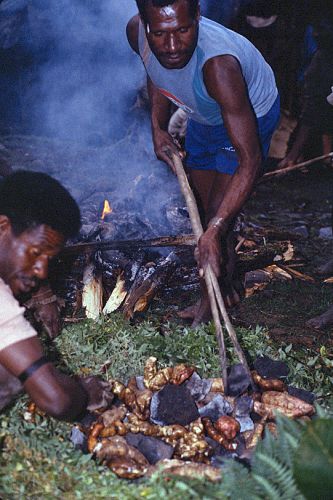 Porter preparing the hole for cooking
Porter preparing the hole for cooking
The porters proceeded to build a large fire made up of alternating layers of wood and rocks. Once the fire was going they dug a hole about 3 feet deep and 4 feet in diameter nearby. After the fire had consumed most of the wood they then took sticks 1-2 inches in diameter and split the end up for about 2 feet. They used these split sticks to pick up the hot rocks in the fire and line the bottom and walls of the hole with them. They then put a layer of wet grass and leaves in the hole and then another layer of rocks. They continued doing this and at various points they put the cuscus, squash, and potatoes in also. When they were done there was a steaming mound about a foot high where the hole had once been. After only an hour or so, and by then it was very dark, they started unpacking the mound with their bare hands. By feel, they could identify the edible leaves, potatoes, squash, and finally the real prize: the cuscus. We soon helped out by pointing a couple of flashlights into the hole for them. The porters passed pieces of steamed squash to us and we enjoyed eating with them in the dark. We tried a small bit of the cuscus, but we wanted to let them keep most of it for themselves. They had obviously been relishing the thought of chowing down on it for the last couple of hours. They were small animals and there were almost 20 porters plus the old man.
While we all stayed in one hut the porters and the old man stayed in the other. In addition, there was a small shack where the cooking was done. That night after the small feast the porters seemed to be in an especially happy mood. After the feast the porters and the old man all retired to their hut. They had a fire going and they were all sitting around it singing/chanting for hours. Looking through the small doorway they could see me and a couple of others outside and invited us in. We crouched down to get inside the small, cramped hut and just watched and listened almost entranced to the sights and sounds. We were all sitting cross-legged on the straw floor and there was a pig just at my feet. The old man occasionally rested his hand on it to restrain it from wandering around the hut. He would stroke the hair on its neck and the back of its head absent-mindedly. That night while in the hut I had such an intense feeling that what I was witnessing and experiencing was probably very little changed from a scene 500, 1000, or even 5000 years ago.
A few days later Rufus told me that the songs told stories and Gupy (my porter) was especially good at composing songs "on the fly." The last night of the trek Gupy was leading the others in singing and Rufus told us that he was singing about the trek we had just completed and how we had walked very far and very hard and it had been good.
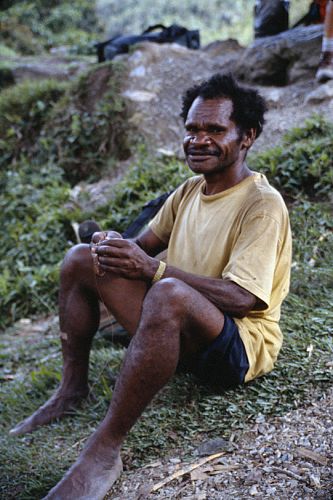 Amius
Amius
Day 6 of the trek became known as the Day From Hell. It was the longest and hardest day of the trek. We started a couple of hours earlier than usual and it turned out to be a 12 hour day of hiking over 4 peaks. The first and highest was almost 3500 meters high, according to Rufus. Everyday we were in Irian Jaya it rained, but usually we were fortunate and the rain did not begin until 6:00 or 7:00 in the evening and lasted most of the night. Usually the days were either sunny or just overcast. On this day, however, the rain started soon after starting out and lasted almost all day. We first had to cross the river again to the other side and head back up through the jungle. We eventually reached enough altitude that we left the jungle behind and then started almost straight up for several hours. Everytime it appeared that the peak was in sight we would discover upon arrival that it wasn't the peak at all and that what appeared to be the actual peak was much higher and further away. For part of the way my friend Amius (one of the porters) and I were walking one behind the other and several times he said (more to himself than me?), "No good. Very no good." It made me feel somewhat better to know that even for the porters this was not an easy day. Most of us were wearing T-shirts and shorts, but as we got higher the rain became colder and colder and most started pulling out rain jackets to put on. I did not have my rain jacket in my daypack and Gupy was not in sight so I couldn't get mine out of my backpack. Finally I arrived at the top and found Gupy resting there. Gupy and Amius were barefoot and wearing old shorts and T-shirts. I got my rain jacket out of my pack and also pulled another jacket out. I had planned to give it to Gupy after the trek, but I didn't have the heart to put on my rain jacket and leave him as he was. I gave him the jacket and he was so happy. I didn't have anything for Amius so I let him wear my hat to at least keep the cold rain out of his face. He was very happy with even that.
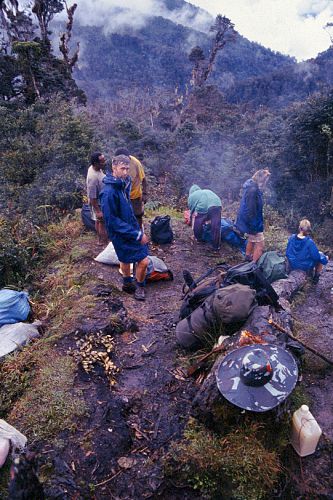 Lunch break on Day 6
Lunch break on Day 6
From there it was down and then up and down 3 more times. We had no advance knowledge how long this day was going to be because Rufus had not told us that it was to be an unusual day. After a short lunch break of cold, left-over from breakfast, fried rice Gupy (who spoke no English) took my arm and wanted me to get up, grab my daypack, and start walking. That was unusual for him to behave in that way, but I followed. I thought maybe he had something he wanted to show me, but we just kept going. After going over the last peak we seemingly went down forever. We were losing most of the altitude we had gained with so much effort in the morning on the other side of the mountain range. Going up had been difficult, but it was nothing compared to going down. Everywhere there were slippery logs, tree roots, and rocks on the steep downward trail and it went on for hours with only occasional breaks for crossing rushing streams and climbing almost straight up out of the stream gorge for awhile. The continuing rain only made things worse. Gupy and I were far ahead of all the others. He was trying to go at a much faster pace than I wanted to, considering the conditions, but everytime I tried to slow down he would motion for me to hurry. In the worst places he would take my hand to help me get through them faster. When I wanted to rest he would motion for me to keep going or only let me take a break of 30-60 seconds (just enough to catch my breath). After a few hours of this I was beginning to wonder why he was in such a hurry. Finally around 4:00 when we were still on the steep path in the depths of the jungle I started to seriously wonder how much further. We generally stopped around this time and it seemed obvious that we weren't near any villages. I tried to ask him if it was far or very far. He just repeated "very far." I wasn't sure he understood my question, but I was beginning to think that the reason that he had wanted me to leave the others behind and start walking as soon as I had finished lunch was because he knew we had a very long way to go and it would be difficult to make it to our destination before it got dark.
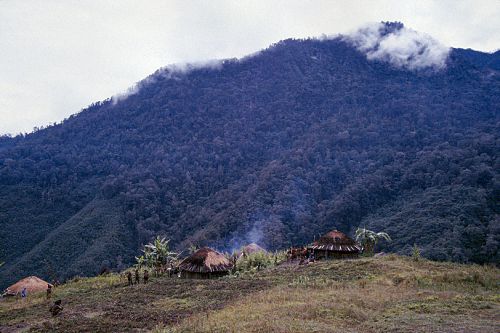 Day 6 village on morning of Day 7
Day 6 village on morning of Day 7
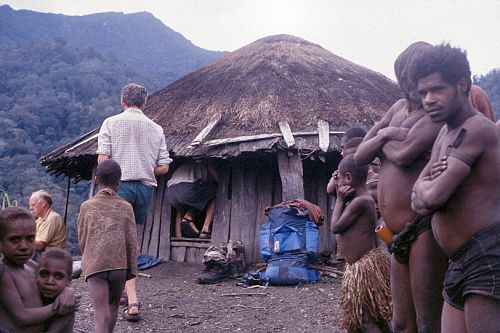
Finally about 5:30 PM we emerged from the jungle and soon we reached a point in the trail that overlooked a small village. In less than 30 minutes Gupy and I arrived. We were the first there and it was almost dark as we walked up to the first hut. Slowly the others started to appear. About half arrived after dark and as most of our group sat in the hut we were still waiting for Chelsea and Angela to arrive. It was apparent that they had not made it out of the jungle before the light had failed and we all hoped that they had a flashlight and one of the porters was with them. After a fairly long wait we were getting concerned and we decided we should try to talk to the porters to tell them we needed to go searching for them. About that time they stumbled alone into the village. Chelsea did not have her flashlight with her (she had left it in her backpack that her porter Mouse was carrying) and Angela's flashlight batteries were almost dead. It just put out a faint yellow glow.
Inside the hut we all just collapsed and it was extremely quiet for the longest time. We were all exhausted so we had no energy even to speak. With great effort I removed my boots and straightened out my legs. By the time dinner was ready we had regained a bit of our energy and during dinner the food restored us to near normal banter.
All during dinner the headman of the village sat against the wall inside the hut with us and just watched and listened. We must have been quite a perplexing sight for him! He wore a very large horim about 18 inches long and about 3 inches in diameter. We served him some of our food and handed him the plate. He was surprised at first, but then started to eat. He seemed to enjoy the food as it was quite different from what he normally ate. Probably 90% of what they eat are the sweet potatoes that they stick in the fire to bake. The Lani people are often seen with a whole, baked sweet potato in their hands that they are eating.
We only had a single candle for illumination and after dinner we noticed in the dim light the reflection of two sets of childrens' eyes peering in through the little doorway. We surmised that they were the headman's children so we motioned for them to come in. They were completely nude and huddled very close to their father for warmth. We offered them some cookies that we had brought along and they especially enjoyed those. The 3 of them sat there quietly for more than an hour as the rest of us talked about the day and then got into a long discussion about the U.S., British, and Australian welfare systems. :-)
We all hoped that there would not be another "Day 6." We had many other difficult days and some of them had more difficult aspects, but none that had the combination of the very long day, the arduous hike, the rain, and for some, the dark descent through the jungle. For the rest of the trek my knees, ankles, and feet were in pain. That night we all thanked God that Jery had not been with us. He would have never made it -- and what that would have meant for the rest of us we didn't even want to contemplate.
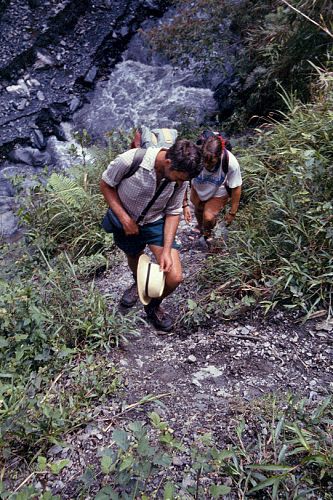 Garry and Angela climbing a steep trail
Garry and Angela climbing a steep trail
In Irian Jaya the mountain trails almost always go the most direct route: straight up or straight down. There is very little zig-zagging back and forth up a steep mountain. And when they traverse the side of a mountain they are often very narrow, only the width of one of my feet (~12 cm), and with drop-offs to deep gorges with boulders and raging rivers below. They are almost always very slippery mud.
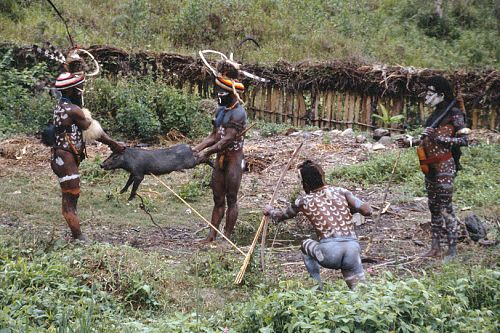 Killing the pig
Killing the pig
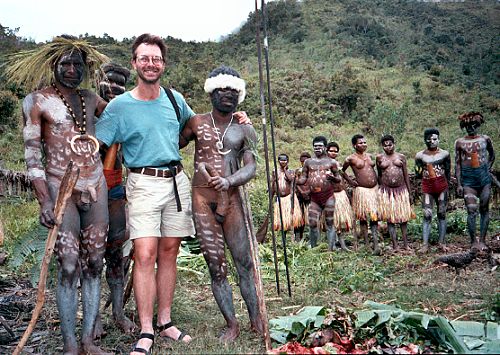 Me with Lani people
Me with Lani people
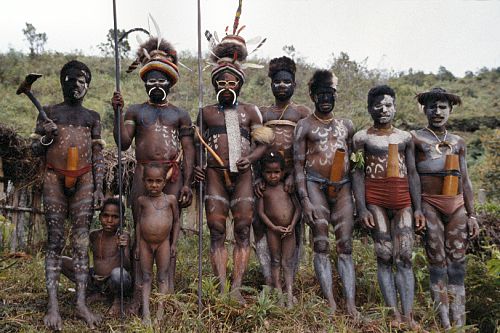
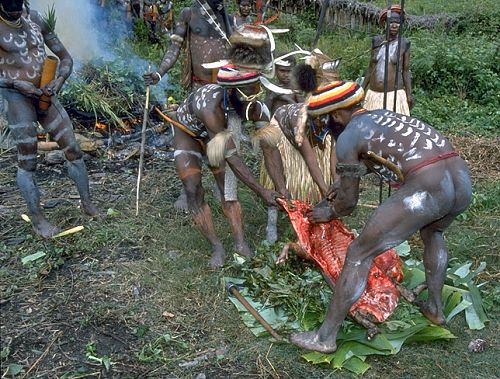 Butchering the pig
Butchering the pig
The morning after we woke up in the hut with the multitude of rats we experienced a pig feast put on by the village. A pig was selected, one man held its ears while another held its hind legs and they lifted it off the ground. Another man then stood about 6 feet away and aimed an arrow at the pig's heart and released. He then grabbed the shaft of the arrow protruding from the pig and "stirred" it around a few times and withdrew it. The two men released the pig and it walked around for awhile and squealed until the 3 men, apparently, decided that the heart must have been missed. They then picked the pig up and shot the pig again. This time the pig seemed much less energetic after being released and after a few minutes collapsed. They spread some banana leaves on the ground and butchered the pig and prepared it to be cooked. Previously a fire and hole had been prepared similar to the one used to cook the cuscus in the jungle several days earlier -- only larger. Before, during, and after the pig slaughter there was ceremony involved. It was obvious that there was a method in the way things were done. In addition, all the people of the village had dressed up in their finest with exquisite horims on display, paint on faces and bodies, pig teeth necklaces on, and feathers in the hair of many.
One morning, near the end of the trek, Garry and I were walking along the trail together when we noticed a Lani man approaching. Something about his penis gourd seemed unusual though. As he got closer we noticed that it was green! Then, as we passed each other on the trail we realized that his penis gourd was made from a 12 inch piece of green plastic pipe! After Garry and I had "Wa'ed" him and he had "Wa'ed" us and continued on his way I turned to Garry and told him that we had just seen an amazing sight. This was a true Lani Renaissance Man. He had seen the future and had seized it. He had boldly stepped into the 21st Century and was rapidly leaving his Lani brethren behind stuck in the dark past. He had made that rare mental leap and had seen the wonderful possibilities that modern civilization had to offer the Lani people. :-)
Lani men who were close friends would often walk hand in hand together. One day near the end of the trek Gupy and Amius started walking beside me and each took one of my hands. While elsewhere this would have been rather an uncomfortable situation and if it had been earlier in the trek I would have have certainly felt uncomfortable, by now I had seen the Lani men do it enough to know it was a gesture of friendship. So we walked happily hand in hand.
The last day of the trek we reached a dirt road and walked along its steep ups and downs for a few hours until we reached a small town. Such a blazing, hot day! There Rufus arranged for 3 vehicles to take us back to Wamena. We drove for about 2 hours and pulled into Wamena in the mid-afternoon. It felt so strange to ride in a vehicle again!
The trek had been difficult, a bit dangerous, and outstanding. We had been able to meet people that have, even now, had little contact with the outside world and who's life is little changed from what it has been for centuries. If it had been an easy trek then possibly many others would have preceded us. Since it was difficult and long few had come that way.
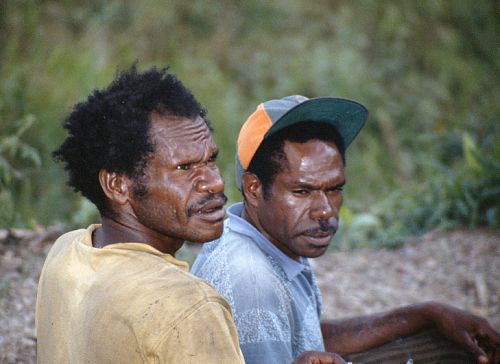 Amius and Abby
Amius and Abby
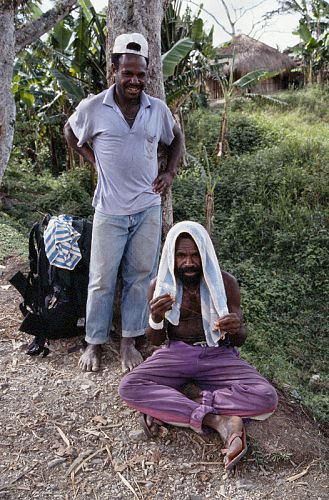
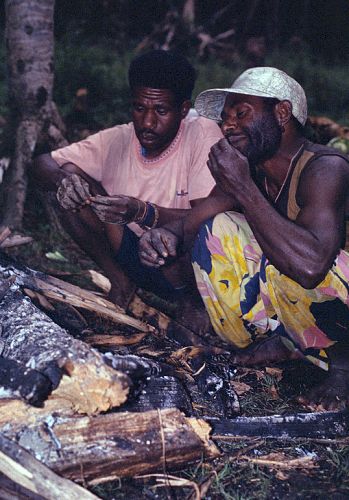 Mouse and another porter
Mouse and another porter
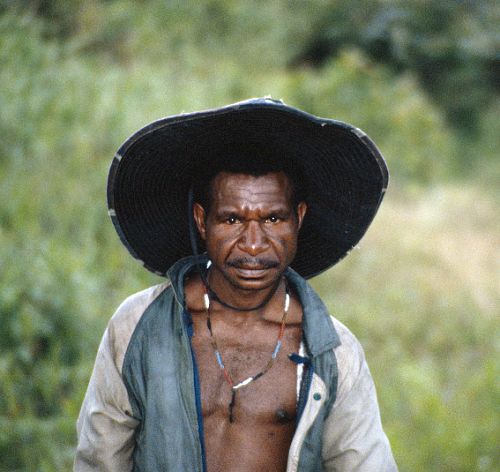
Leaving Rufus, Gupy, Amius, Janus, Mouse, Abby, and all the other porters was difficult. I had already given my jacket to Gupy and even on the hottest days he wore it and had it snapped up all the way to the neck. I also gave him a nice tip and some socks. I wanted to give him my hiking boots, but I had to have them for the rest of the trip. I gave Amius my hiking shorts and a T-shirt. Amius often had leaves and flowers stuck in his hair and he always greeted me with, "Hello, my friend!" Several times he tried to convince me to stay in Irian Jaya and marry a Lani woman. On two or three occasions he told me, "Indonesian woman, bad. Lani woman, very, very good!" He assured me that he could help me buy some pigs and then help me find a good wife to buy with the pigs. Gupy and Amius (my favorites) had grown up in the same village and had known each other since childhood. Gupy was one year older than Amius. As we were parting they asked me to please return to Irian Jaya someday. I hope to!
Sometime after this trip I read in a book an interesting anecdote concerning the people in the Central Highlands of Irian Jaya where we had been. Someone had told them about the Asmat people in the south of Irian Jaya and that the men there didn't wear penis gourds. Upon hearing this they were very concerned for the poor Asmat men so they took up a collection of penis gourds in hope that someone could deliver them to the Asmats. No one should be deprived of the civilizing influence of a properly worn penis gourd, in their opinion. They felt real concern for their poor brethren in the south. Of course, the Asmat people have a quite different culture and that is why they didn't wear penis gourds. :-)
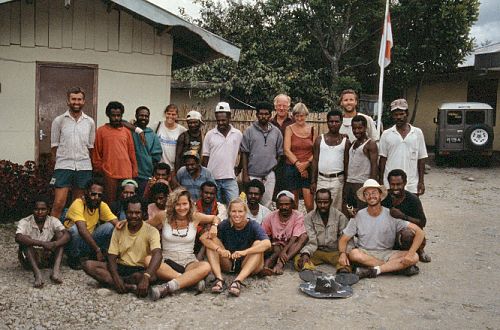 Us back in Wamena
Us back in Wamena
We spent the night in Wamena and then early the next morning we were able to get on the plane back to Sentani. Upon landing in Sentani we were all surprised to be greeted by Jery! He had actually waited for us! We had all assumed that he would get tired of waiting and would probably either go home or maybe fly to Bali to try to salvage part of his trip.
In Sentani we gathered up the stuff that we had left behind and decided to not spend the night. We were fortunate to be able to get on the next plane to Biak on Pulau Biak (Biak Island), to the north of New Guinea. The flight to Biak turned out to be an adventure on its own. By the time the plane arrived at Biak there was a raging rain storm and although I had a window seat I could see nothing. I knew we were descending but as the plane rocked back and forth in the wind all I could see out of the window was white. I was sitting on the port side (left side) of the plane behind the wing and I could just make out the end of the wing tip. Suddenly the ground appeared just about a foot from the wing tip! Just at that moment the plane rocked back to the other side as the tires hit the runway and we landed without the plane cartwheeling down the runway. That was the closest I have ever come to a plane crash.
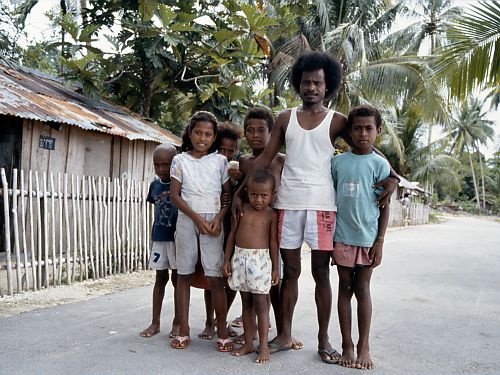 Family on Biak
Family on Biak
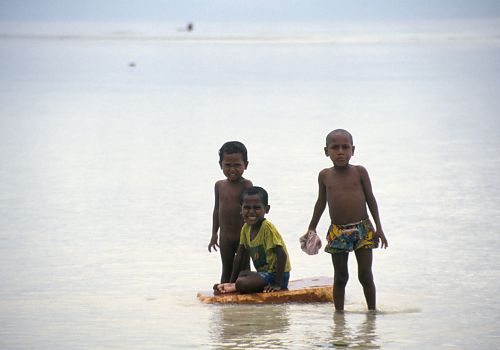 Boys playing
Boys playing
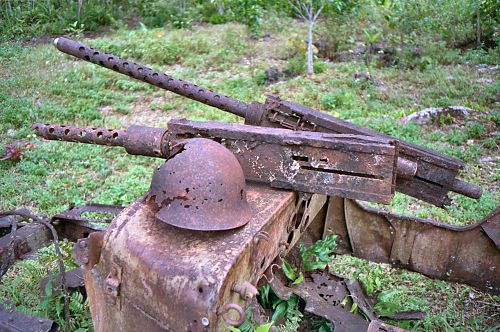 WWII war materiel
WWII war materiel
We relaxed in Biak for two nights and recovered from the trek. We had showers, sat in chairs, ate at a table, and slept in beds. It was wonderful! Some of us went out to the Gua Jepang (Japanese caves) where more than 10,000 Japanese soldiers lived during World War II. They hid there during the day and would come out to attack the American Marines at night. About 5000 of the Japanese died in the caves from bombs and fire attacks. There are still many items of Japanese and American war materiel on Biak Island. I saw rusted machine guns, bombs, helmets, vehicles, landing craft, propellers, etc..
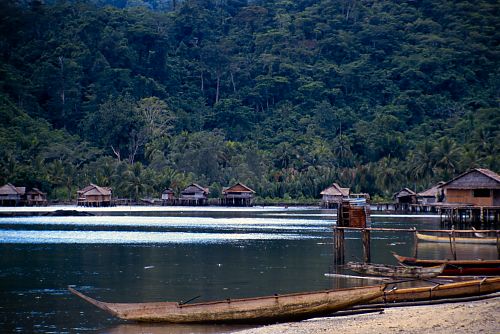 Village 1 on Yapen
Village 1 on Yapen
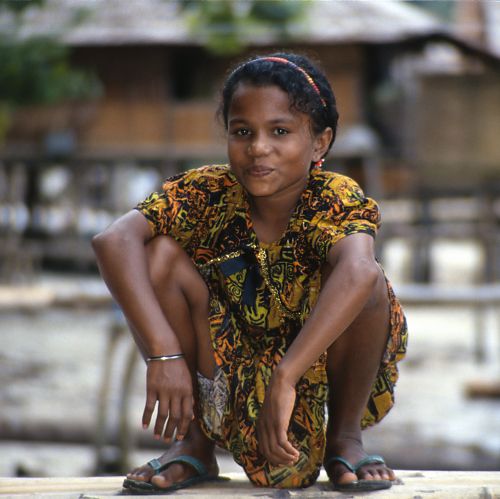
After two days on Biak we decided to hire a guide and an outrigger canoe to take us to Pulau Yapen (Yapen Island) to the south of Biak Island (but to the north of New Guinea). Although the mountains of Yapen Island seemed fairly close it took almost 6 hours across the ocean for the small outboard motor powered outrigger to get there. We spent the night at a little 3 hut village on the beach -- just like something out of the movies. The huts were on poles about 3-4 feet off the ground and in the evening when the tide came in the water was almost to the door of the first hut (the one we stayed in).
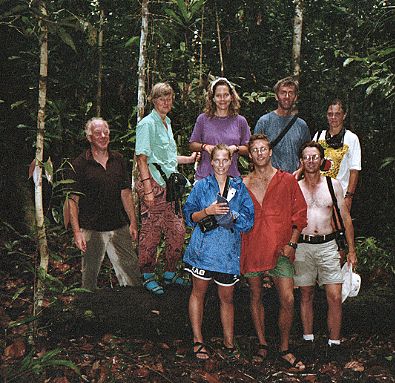 Us
Us
That evening we went out in the jungle in search of the Bird of Paradise. The local guide led us to the base of a tree where he said the birds like to congregate. Sure enough, high up in the canopy we could hear several Birds of Paradise and soon could make out their beautiful, long, yellow tail feathers.
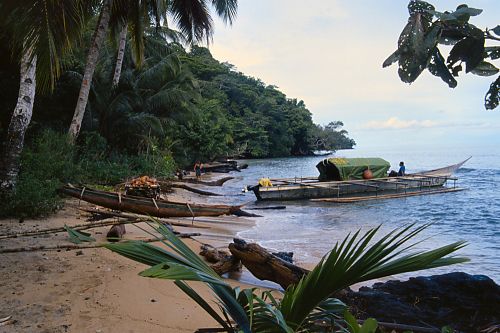 Our outrigger
Our outrigger
After going out and seeing the Birds of Paradise again in the morning we loaded the outrigger up and set off for Pulau Aibai (Aibai Island). It is a small, uninhabited island between Biak and Yapen. After a couple of hours we arrived at a gorgeous white-sanded beach that surrounded a grove of trees in the center. The circumference of the island could be walked in less than 10 minutes!
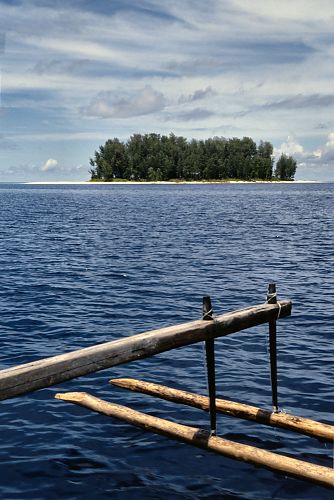 Aibai
Aibai
We had several hours until dark so some of us snorkeled in the phenominally clear water and explored the coral reef on the east side of the island. The fish there were of every hue and color. I especially liked the many bright blue starfish.
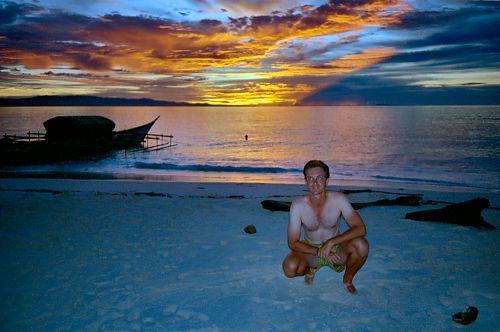 Me at sunset on Aibai
Me at sunset on Aibai
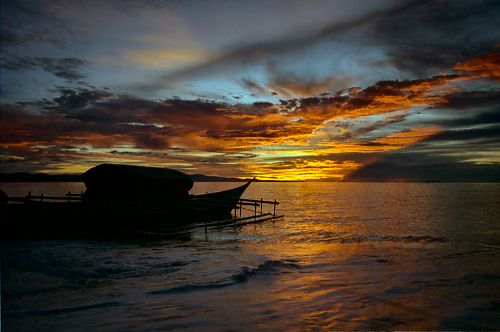
That evening we were blessed with one of the most glorious sunsets I have ever seen. It was perfect! The others all slept in a tent that night, but I just spread my sheet on the sand and slept there all night. The stupendous dark sky inset with countless stars was above me as I lay on the beach and I found it hard to close my eyes and sleep -- the occasional crab that crawled onto my sheet in the dark also startled me out of sleep several times. :-} I relived the previous few weeks of adventure in my mind, knowing that it was almost over. Lying there Bob Dylan's lines in Mr. Tambourine Man, kept playing through my mind:
Take me disappearing through the smoke-rings of my mind
Down the foggy ruins of time
Far past the frozen leaves
The haunted, frightened trees
Out to the windy beach
Far from the twisted reach of crazy sorrows.
Yes, to dance beneath the diamond sky
With one hand waving free
Silhoetted by the sea
Circled by the circus sands
With all memory and fate
Driven deep beneath the waves
Let me forget about today until tomorrow.
Then Bruce Springsteen's words in No Surrender stayed with me the rest of the night:
I want to sleep beneath peaceful skies
In my lover's bed
With this wide open country in my eyes
And these romantic dreams in my head.
It was a magical night.
The next morning, while the others were still sleeping, I got up to walk around about 5:00 AM and see the sunrise. I soon noticed that the tide was lower than it had been before sunset the night before and I could see something in the clear water where it was less than a foot deep. Upon closer inspection it appeared to be some sort of rusted artillery shell. As soon as it got lighter I got my snorkel gear and explored the water on that side of the island. I found 4 small bombs (4 feet long, 18 inches in diameter) and 2 large bombs (6-7 feet long, 3 feet in diameter). All of the explosive had been removed and they were hollow inside. Inside of one of the large ones there were 3 poisonous lion fish. The first time I investigated that bomb 2 of the fish were floating just outside the entrance to the interior so I could see them clearly only 3-4 feet in front of me. Later I brought Garry to see them, but they had moved inside and were less clearly visible. We then went over to the reef on the other side of the island to snorkel some more.
About 1:00 PM we loaded the outrigger again and headed back to Biak. We spent the night there and the next morning, October 28th, we all dispersed. I flew on to Jakarta and then from there to Honolulu and Los Angeles. From there I caught a shuttle flight to San Jose and got home about 1:00 AM on October 29th. It took about 31 hours to return home.
What a wonderful trip!
Black & White Irian Jaya/West Papua New Guinea photos are here: B&W West Papua New Guinea
A few more Irian Jaya/West Papua New Guinea photos are here:
1,
2,
3,
4,
5,
6,
7
Biak/Yapen/Aibai Islands Photo Gallery
HOME